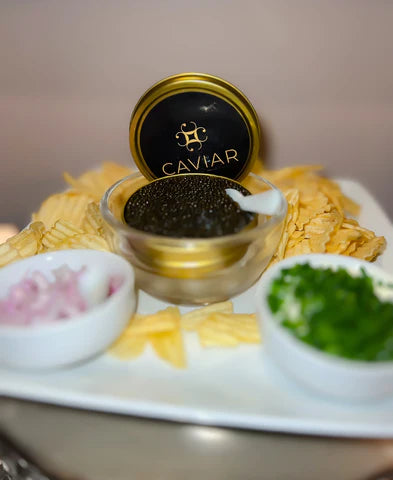
What caviar is the best
Share
<h1 id="1">what caviar is the best</h1><p>Caviar is a delicacy that has long been associated with luxury and indulgence. With its rich flavor and smooth texture, it is no wonder that caviar is often considered the epitome of fine dining. However, with so many different types of caviar available in the market, it can be overwhelming to determine which one is the best. In this article, we will explore the qualities that make caviar exceptional and guide you in choosing the best caviar for your taste buds.<h2 id="2">What Caviar is the Best?</h2><p>When it comes to caviar, the word "best" is subjective as individual preferences play a significant role. Some caviar enthusiasts prefer the creamy and buttery flavor of Beluga caviar, while others favor the briny and nutty taste of Osetra caviar. Ultimately, the best caviar is the one that pleases your palate the most.</p><p>However, there are certain factors to consider when determining the quality of caviar. These include the size, color, texture, and flavor characteristics. Let's dive into each of these aspects to help you make an informed decision.</p><h3 id="3">Size</h3><p>The size of caviar eggs can vary significantly. Larger eggs tend to have a more pronounced pop when bitten into, while smaller eggs offer a more delicate texture. The size of the eggs doesn't necessarily indicate the quality, but it does impact the overall experience of consuming caviar. Some prefer the burst of flavor from larger eggs, while others enjoy the subtlety of smaller eggs.</p><p>Additionally, the size of the eggs can also affect the visual appeal of the dish. Larger eggs create a more striking presentation, while smaller eggs can be used to garnish various dishes with precision and elegance.</p><h3 id="4">Color</h3><p>Caviar can come in various colors, ranging from pale grey to dark brown. The color is influenced by the species of the sturgeon and their diet. Beluga caviar is known for its light grey to black color, while Osetra caviar is typically brown or amber. The color doesn't necessarily affect the taste, but it can enhance the visual appeal of the dish.</p><p>Moreover, the color of caviar can also be an indicator of its age. As caviar ages, it tends to darken in color, which some connoisseurs believe adds complexity to the flavor profile. However, others prefer the vibrant and lighter hues of younger caviar, as they associate it with freshness and vitality.</p><h3 id="5">Texture</h3><p>The texture of caviar is an essential aspect of its overall quality. High-quality caviar should have firm and intact eggs that burst gently in your mouth, releasing an explosion of flavor. The eggs should not be mushy or overly soft, as this indicates poor quality or improper handling.</p><p>Moreover, the texture also depends on the curing process. Traditional Russian caviar is lightly salted and cured to maintain its delicate texture, while some modern variations may undergo different processes that can affect the texture. For example, some caviar producers use innovative techniques to create a unique texture, such as flash freezing the eggs to preserve their integrity and create a delightful crunch.</p><h3 id="6">Flavor Characteristics</h3><p>The flavor of caviar can vary depending on its origin, the species of sturgeon, and the conditions in which it was raised. Beluga caviar is often described as buttery and mild, while Osetra caviar has a nutty and fruity taste. Sevruga caviar tends to be more robust and briny.</p><p>Some caviar enthusiasts enjoy the complexity and depth of flavor that older caviar develops, while others prefer the freshness and subtle flavors of younger caviar. Additionally, the flavor of caviar can be influenced by the environment in which the sturgeon was raised, such as the temperature and salinity of the water. These factors contribute to the unique flavor characteristics that make each type of caviar distinct and sought after.</p><h2 id="7">What Caviar is Orange?</h2><p>While most caviar is known for its shades of black, grey, or brown, there is one type of caviar that stands out with its vibrant orange hue - the American Hackleback caviar. This caviar comes from the Shovelnose sturgeon, which is native to the Mississippi and Missouri Rivers in the United States.</p><p>The Hackleback caviar has a distinctive flavor that is reminiscent of wild Caspian Sea caviar. Its small to medium-sized eggs provide a burst of flavor and are often compared to the prized Beluga caviar. The vibrant orange color adds a visual appeal to any dish, making it a popular choice among chefs and caviar enthusiasts.</p><p>When it comes to the harvesting process, the American Hackleback caviar is carefully hand-selected to ensure only the highest quality eggs make it to your plate. The sturgeon is caught using sustainable fishing methods, ensuring the preservation of this remarkable species for generations to come.</p><p>Once the sturgeon is caught, the eggs are gently extracted and meticulously cleaned to remove any impurities. This delicate process requires great skill and precision to maintain the integrity of the eggs and preserve their natural flavors. The result is a caviar that is not only visually stunning but also a true delight for the taste buds.</p><h2 id="8">What Caviar is the Most Expensive?</h2><p>When it comes to luxury food items, it is no surprise that caviar can come with a hefty price tag. The most expensive caviar in the world is typically Beluga caviar, which comes from the Beluga sturgeon found primarily in the Caspian Sea.</p><p>The Beluga sturgeon is the largest species of sturgeon, and its eggs are known for their large size and delicate flavor. Due to its rarity and declining population, Beluga caviar commands a premium price in the market. The traditional harvesting methods, strict regulations, and limited supply contribute to its exclusivity and high cost.</p><p>Let's delve deeper into the fascinating world of Beluga caviar. The Caspian Sea, where these magnificent creatures reside, has been a prime source of caviar for centuries. The sturgeon, with its sleek and majestic appearance, has captivated the imaginations of people around the globe. Its long lifespan, reaching up to 100 years, adds to the allure of this remarkable species.</p><p>Beluga caviar is renowned for its unique characteristics. The eggs, or roe, are exceptionally large, ranging from 2.5 to 3.5 millimeters in diameter. The color of the eggs can vary from light gray to black, with a glossy sheen that adds to its visual appeal. The texture is smooth and buttery, melting in your mouth and leaving a lingering taste that is both rich and delicate.</p><p>Obtaining Beluga caviar is no easy feat. The traditional method of harvesting involves carefully catching the sturgeon and extracting the eggs by hand. This meticulous process ensures the highest quality caviar, but it also contributes to the limited supply and high price. Additionally, strict regulations are in place to protect the Beluga sturgeon population from further decline, making the acquisition of Beluga caviar even more exclusive.</p><p>Despite its high cost, Beluga caviar continues to be sought after by connoisseurs and enthusiasts alike. Its exquisite flavor and luxurious reputation make it a symbol of indulgence and sophistication. Whether enjoyed on its own or as a garnish, Beluga caviar elevates any culinary experience to new heights.</p><h2 id="9">Why Caviar on Hand?</h2><p>Having caviar on hand allows you to indulge in this exquisite delicacy whenever the mood strikes. When properly stored, caviar can have a surprisingly long shelf life. It is important to keep caviar refrigerated between 28°F and 35°F (-2°C and 2°C) to preserve its freshness.</p><p>Caviar should be stored in its original container, tightly sealed, and placed on ice or in the coldest part of the refrigerator. It is crucial to avoid exposure to air and fluctuations in temperature to prevent spoilage. By keeping caviar on hand, you can savor its unique flavors and impress your guests with a touch of luxury.</p><p>But what makes caviar so special? It's not just the taste, but also the rich history and cultural significance that surrounds this delicacy. Caviar has been enjoyed by royalty and aristocrats for centuries, symbolizing wealth, opulence, and sophistication. The process of harvesting caviar from sturgeon, the fish that produces this prized delicacy, requires great skill and precision. From the careful selection of mature fish to the delicate extraction of the eggs, every step is carried out with utmost care to ensure the highest quality product.</p><p>Furthermore, caviar is not just a treat for the taste buds, but also a nutritional powerhouse. Packed with essential nutrients like omega-3 fatty acids, vitamins, and minerals, caviar offers a range of health benefits. It is known to promote heart health, boost brain function, and enhance skin radiance. So, by having caviar on hand, you not only indulge in a luxurious culinary experience but also nourish your body with its goodness.</p><p>In conclusion, determining the best caviar is a matter of personal taste and preference. The size, color, texture, and flavor characteristics all contribute to the overall experience of consuming caviar. Whether you prefer the creaminess of Beluga caviar, the nuttiness of Osetra caviar, or the vibrant hue of Hackleback caviar, the world of caviar offers a plethora of options for different palates. So go ahead, explore the world of caviar, and indulge in the finest delicacy that the culinary world has to offer.</p></p>

